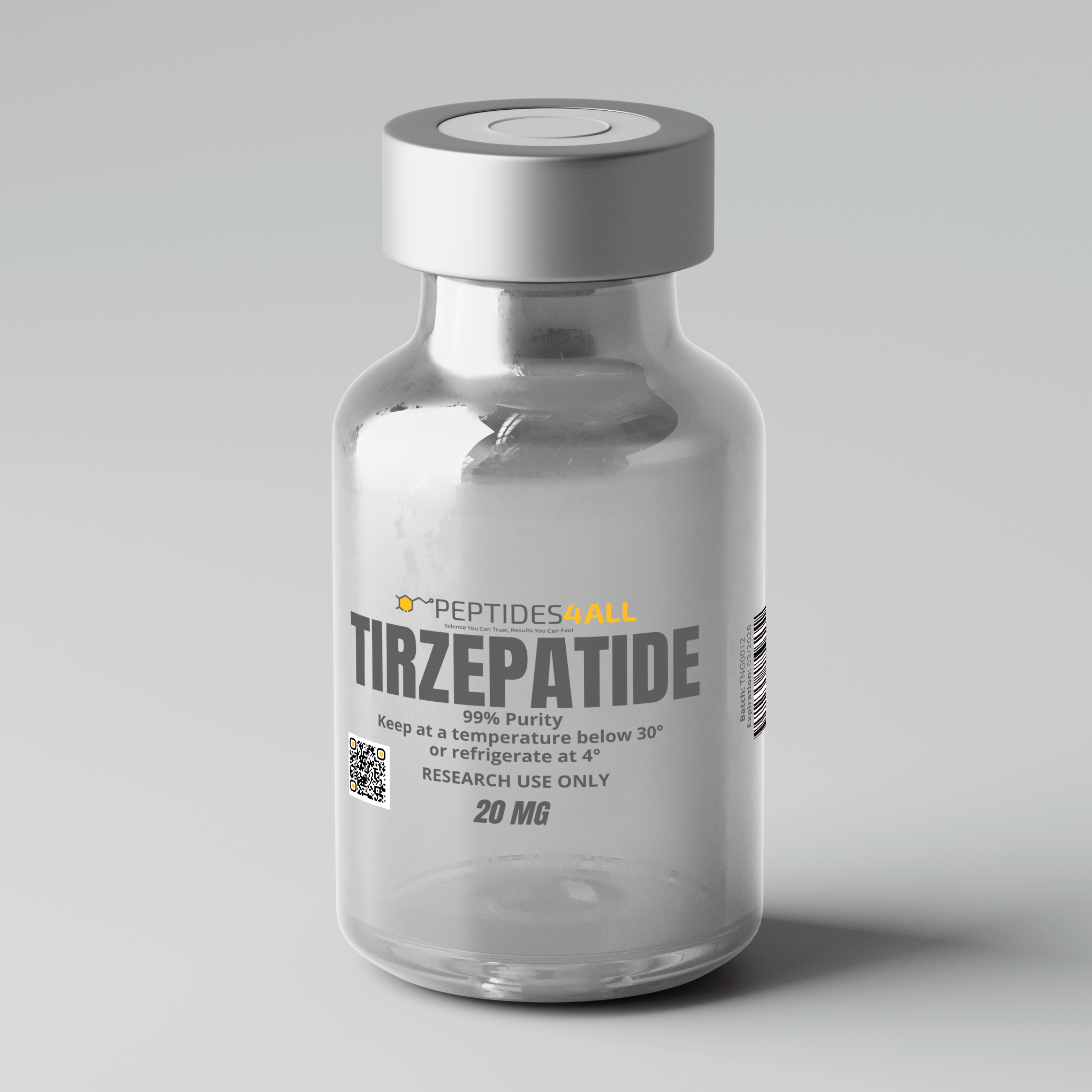PEPTIDES4ALL Tirzepatide – Dual GIP / GLP-1 Receptor Co-Agonist for Metabolic & Obesity Research
PEPTIDES4ALL Tirzepatide (LY3298176) is a synthetic 39–amino acid peptide that represents a breakthrough in metabolic peptide research through its dual activation of the GIP (glucose-dependent insulinotropic polypeptide) and GLP-1 (glucagon-like peptide-1) receptors.
By engaging both incretin pathways simultaneously, Tirzepatide mimics and amplifies the body’s natural hormonal regulation of insulin secretion, appetite, glucose metabolism, and energy expenditure.
This dual incretin mechanism positions Tirzepatide as part of a new class of multi-receptor agonists that expand beyond traditional GLP-1 analogues.
While GLP-1 receptor activation primarily enhances insulin secretion and satiety, GIP receptor engagement further improves β-cell responsiveness, lipid metabolism, and adipose insulin sensitivity, producing synergistic metabolic effects (New England Journal of Medicine, 2022; Nature, 2022).
Mechanistically, Tirzepatide exhibits a unique receptor bias at the GLP-1 receptor, favoring cAMP-mediated signaling over β-arrestin recruitment, which may extend receptor activity while minimizing desensitization during prolonged use (JCI Insight, 2023).
This biochemical behavior, combined with its balanced co-agonist profile, allows Tirzepatide to deliver a multi-dimensional modulation of glucose control, weight reduction, and energy homeostasis across multiple organ systems.
In both preclinical and human trials, Tirzepatide has demonstrated superior metabolic outcomes compared with GLP-1 receptor agonists alone—achieving profound HbA₁c reduction, body-weight loss exceeding 20%, and favorable shifts in lipid, hepatic, and renal biomarkers.
Its broad spectrum of activity makes it a cornerstone molecule for studying metabolic remodeling, obesity physiology, incretin synergy, and peptide-based endocrine therapies.
Scientific Evidence & Research Findings
-
Glycemic Control & HbA₁c Reduction — In clinical trials (SURPASS series), tirzepatide at doses of 5, 10, or 15 mg weekly produced significant reductions in HbA₁c (often >1.5%) in type 2 diabetes patients. JCI Insight+3BioMed Central+3New England Journal of Medicine+3
-
Substantial Weight Loss — In obese, non-diabetic populations, weekly tirzepatide over 72 weeks led to substantial weight reductions: up to ~15-20 % mean body weight loss in higher dose groups. New England Journal of Medicine
-
Dual Receptor (GIP + GLP-1) Mechanism — Tirzepatide is designed to leverage synergistic incretin signaling: GIP receptor engagement complements GLP-1 action, improving insulin secretion and metabolic responses beyond GLP-1 alone. PubMed+2JCI Insight+2
-
Biased Agonism at GLP-1R — Mechanistic analyses reveal that tirzepatide favors cAMP signaling over β-arrestin recruitment at the GLP-1 receptor, which may reduce receptor internalization and augment sustained signaling. JCI Insight+1
-
Cardiorenal & Mortality Associations — Real-world and trial data suggest tirzepatide may reduce risks of cardiovascular events, all-cause mortality, acute kidney injury, and adverse kidney outcomes compared with GLP-1 receptor agonists. JAMA Network
-
Structural & Pharmacologic Insights — Cryo-EM and structural studies show how tirzepatide engages GIPR and GLP-1R simultaneously, helping rationalize its potency and receptor binding dynamics. Nature
Key Research Benefits & Applications
-
Dual Incretin Synergy: Simultaneous activation of GIP and GLP-1 receptors provides enhanced glucose regulation, insulin sensitivity, and metabolic flexibility.
-
Potent Glycemic Control: Demonstrated significant HbA₁c reduction and improved postprandial glucose handling in clinical and preclinical studies.
-
Advanced Weight Management Model: Produces profound body-weight loss (15–20%) through appetite suppression, slowed gastric emptying, and improved energy expenditure.
-
Lipid & Hepatic Modulation: Improves lipid metabolism, liver fat content, and markers of nonalcoholic steatohepatitis (NASH) and fatty liver disease.
-
Biased GLP-1 Receptor Signaling: Favors cAMP-dominant pathways over β-arrestin recruitment, supporting sustained receptor responsiveness and reduced desensitization.
-
Cardiorenal & Systemic Benefits: Associated with improved cardiovascular and renal outcomes, making it a versatile model for metabolic and endocrine research.
-
Structural & Pharmacologic Insight: Enables study of multi-receptor peptide engineering, receptor bias, and incretin co-agonist design strategies.
Presentation & Handling
- Form: Supplied as lyophilized peptide in sterile vial.
- Reconstitution: Use bacteriostatic water or 2% procaine; swirl gently (do not shake vigorously).
- Storage: Store at –20 °C, protected from light and moisture. After reconstitution, use according to research protocols and handle under sterile conditions.
Intended Use
For research purposes only. Must be handled in accordance with institutional protocols and ethical guidelines.
